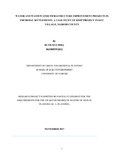| dc.description.abstract | Water and waste water infrastructure service provision is essential for human survival, health and dignity. Human settlements should develop with adequate water and waste water infrastructure services, but in real situation, settlements in particular informal settlements are occurring without adequate water and waste water infrastructure. The main objective of this study was to assess the effect of water and wastewater infrastructure improvement project on informal settlements. Specifically, the study sought to assess whether Kenya Informal Settlements Improvement Program (KISIP) project has improved water and waste water service provision, examine the issues faced in the planning, implementation and management of the KISIP Project, and evaluate the different roles, attitudes and perceptions of the stakeholders in relation to KISIP in the study area. The study used a combination of qualitative and quantitative methods of data collection. This included the use of questionnaires, interviews, observation and document analysis. Quantitative data was analyzed using SPSS qualitative data was grouped in themes and emerging patterns based on the objectives of the study. The results of quantitative data analysis were presented in charts, graphs and tables. The study revealed that the KISIP project has generally not improved water and wastewater infrastructure services in KCC Village. Access to this basic commodity is still poor, water supply from NCWSC is erratic and unreliable, and the drainage of the area is very poor. In addition, human waste disposal facilities are mostly shared amongst households. Although the toilets are connected to the NCWSC sewers, there’s inadequate water supply leading to blockages of the sewerage system, thus inconveniencing the residents. Poor workmanship has resulted to fundamental flaws in the constructed infrastructure such as leaking sewer lines, broken manholes, as well as blocked and unfinished drainage channels. The study further revealed that financial constraints, spatial constraints, inadequate community engagement, and poor project management were the main factors that compromised effective project implementation and management. The study concludes that KISIP project has not considerably improved the water and waste water situation in the study area. The main recommendation of this study is that the government should incorporate all key players/stakeholders in planning, implementation and management of these projects. | en_US |



